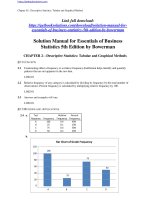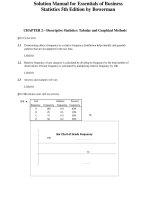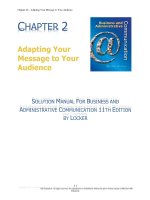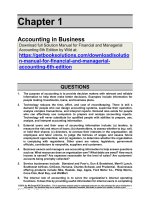Solution manual for operations and supply management 12th edition by jacobs
Bạn đang xem bản rút gọn của tài liệu. Xem và tải ngay bản đầy đủ của tài liệu tại đây (357.04 KB, 4 trang )
Full file at />
CHAPTER 1
INTRODUCTION TO THE FIELD
Review and Discussion Questions
1. What is the difference between OSM and OR/MS? Between OM and IE?
Operations and Supply Management (OSM) is a synthesis of concepts and techniques that relate
directly to production and distribution systems and enhance their management. Operations and
Supply Management has a distinct management role that differentiates it from OR and IE.
Operations and Supply Managers use the tools of OR in decision making and are concerned with
many of the same issues as Industrial Engineers. Operations Research/Management Science
(OR/MS) is a branch of applied mathematics, while Industrial Engineering (IE) is an engineering
discipline.
2. How would you distinguish OSM from management and organizational behavior as taught at
your university?
Management and organizational behavior is concerned with the formulation of corporate strategic
policy. Operations and Supply Management is concerned with the operations strategy, which
specifies how the firm will employ its production and distribution capabilities to support its
corporate strategy.
3. Take a look at the want ads in The Wall Street Journal and evaluate the opportunities for an
OSM major with several years of experience.
The following are some examples of jobs available to OSM graduates with several years of
experience from the Wall Street Journal, January 18, 2000.
buy this full document at
Full file at />
Some additional advertisements.
4. What factors account for the resurgence of interest in OSM today?
With the expanding objectives of productive and distribution systems combined with increased
applications to services and increased efficiency of Japanese producers, there is increased interest
in nuts and bolts issues.
5. Using Exhibit 1.2 as a model, describe the input-transformation-output relationships found in
the following systems:
a. An airline
Inputs: passengers
Components: planes, crews, equipment, terminals
Primary functions: transportation
Output: satisfied, safe customers
b. A state penitentiary
Inputs: criminals
Components: legal system, physical plant (prison), guards and support staff
Primary functions: segregation of prisoners from society, punishment, rehabilitation
Output: reformed society members
buy this full document at
Full file at />
c. A branch office of a bank
Inputs: customers
Components: tellers, bank officers, teller windows, systems
Primary functions: deposit and withdrawal handling, loan initiation, storing money and
valuables
Output: satisfied customers, positive return on loan ratios
d. The home office of a major banking firm
Inputs: paperwork from customers and other institutions
Components: loan underwriters, clerks, computer systems
Primary function: record-keeping, loan processing, coordinating cash flows
Output: satisfied customers, sound investment portfolios
6. Is the DVD accompanying this book a good or a service? Explain?
Looking at exhibit 1.3 - The Goods-Services Continuum, a DVD would fall under Core
Goods, Data storage systems. Your core service provider - your instructor - uses this as a
facilitating good to support his or her class.
7. Define the service package of your college or university. What is its strongest element? Its
weakest one?
The categories with examples are:
Supporting facility - location, buildings, labs, parking.
Facilitating goods – class schedules, computers, books
Explicit services – classes with qualified instructors, placement offices
Implicit services – status and reputation (e.g., Ivy League schools)
At Indiana University and the University of Southern California, among their strongest
elements are their business schools and their Operations Management programs (of course).
Both also have very dedicated alumni networks. A weak element of Indiana University is its
weak football program; for USC, weak elements are on-campus parking and housing.
8. What service industry has impressed you the most with its innovativeness?
Our vote goes to cruise lines which have introduced such onboard innovations as wave
machines for belly boarding and rock climbing walls, as well as all sorts of other amenities to
keep cruisers involved. The industry is doing record business as well.
Some of the standout companies in less innovative industries are Bank of America (has a
formalized research program to try out new customer services/amenities such as video
screens in next to teller lines), Intuit (e.g., putting Quicken money management software
online), Ikea, JetBlue Airlines, and Progressive Insurance (discussed later in the book).
9. What might make the COO’s job at Apple more challenging than that of less innovative
manufacturers?
buy this full document at
Full file at />
Apple's introduction of new products requires its COO to continually refine various parts of
the company's supply chain and to work with new suppliers far more often than less
innovative companies. Also, Apple's well-known secrecy in new product development
requires the COO to keep many of these changes under wraps until the last minute.
10. What are Value-added services and what are the benefits to external customers?
Value-added services make the external customer’s life easier and help carry out their
particular function. They provide benefits in two areas. First, they differentiate the
organization from the competition. Secondly, these services build relationships that build
customers to the organization in a positive way.
11. What is the difference between a service and a good?
A service is an intangible process, while a good is the physical output of a process.
12. Recent outsourcing of parts and services that had previously been produced internally is
addressed by which current issue facing operations and supply management today?
The coordination of relationships between mutually supportive but separate organizations.
buy this full document at









